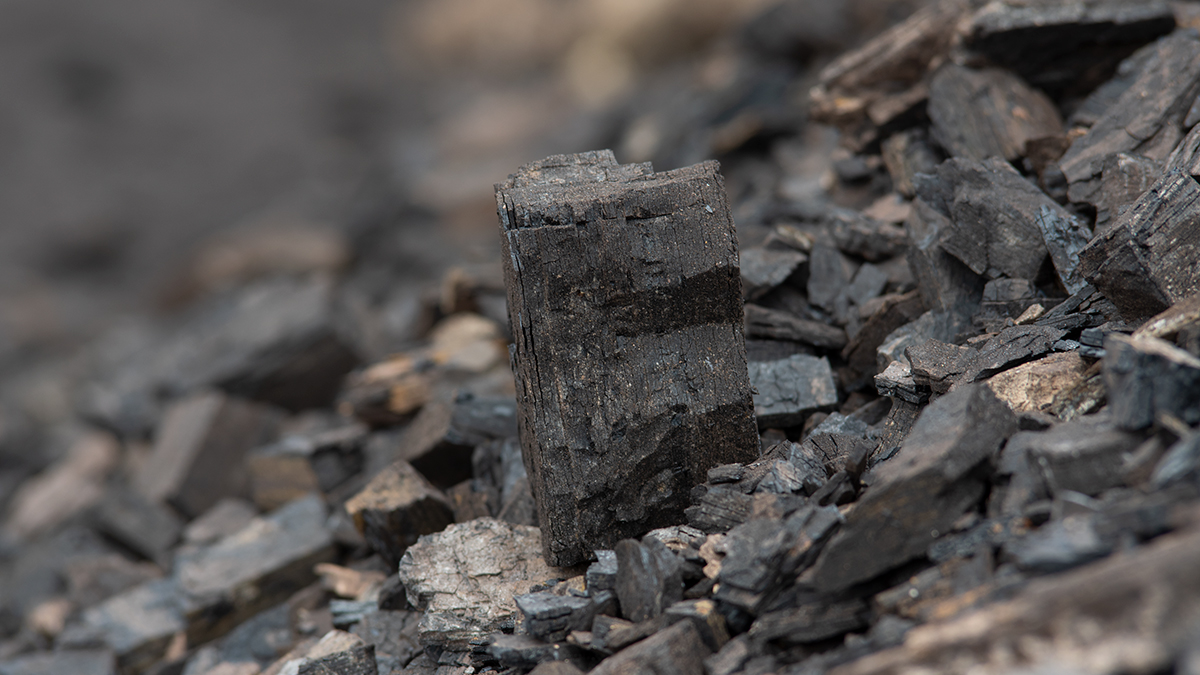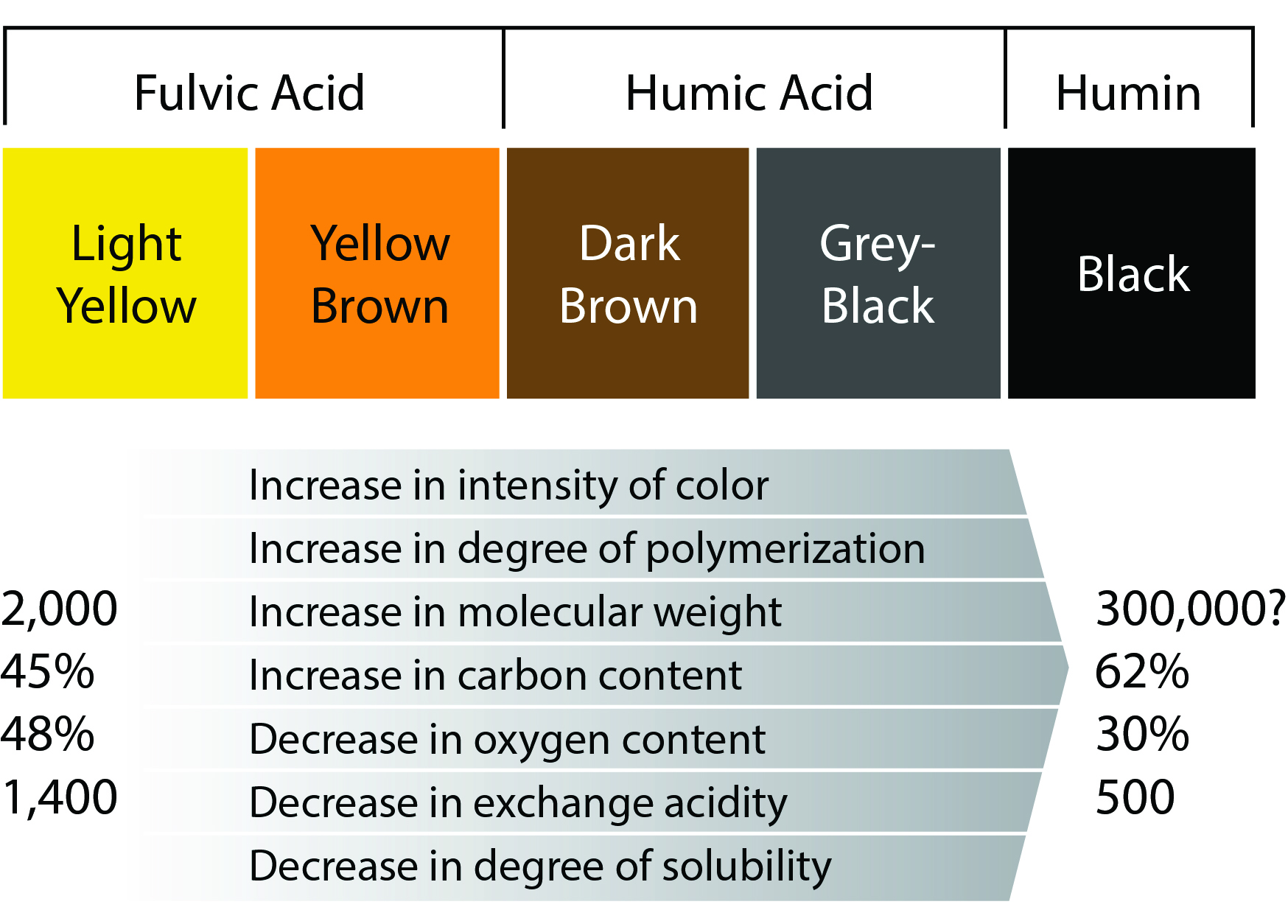By Larry Cooper, with Rita Abi-Ghanem, PhD
Humic substances play an important role in soil fertility and crop yield. This article provides a basic overview of what humic substances are, how they are created, and how they work. Discussion is provided on how to add humic content to crop soil, including the use of commercial products such as the Huma Gro® line of carbon-rich organic acids.
Everyone who works in agriculture is aware of the basic lifecycle of crops: plants are seeded, they are nourished and they grow, they are harvested, and what is not consumed is returned to the soil—where it is broken down through mineralization and by microorganisms so that it can be used to nourish the next cycle of crops. That relatively simple scenario is created by a wonderfully complex interchange of chemical, physical, and biological actions that scientists are still struggling to fully understand after 10,000 years of practical farming.
As with everything else on this planet, the story of humic substances begins and ends with carbon. All life on this planet is carbon-based: humans, animals, plants, insects, microorganisms . . . carbon is essential to building everything biological and keeping it powered and in working order. Plants pull carbon from the air (carbon dioxide) and through a series of reactions merge the carbon with energy from sunlight (photosynthesis) and hydrogen from water, eventually creating carbon-rich organic compounds required by plants throughout their metabolic pathways. A very important characteristic of carbon as an element is that it has a unique capacity to modify itself and, through functional group extensions, combine with many other elements to form shorter and longer carbon chains, rings, and complex organic compounds as required in the processes.1
What Are Humic Substances?
When plants end their life cycle, their components are decomposed through the aid of mineralization and microorganisms and returned to the soil as organic matter. About 70% of soil organic matter is humus, a brown to black complex variable of carbon-containing compounds that is slow to decompose under natural conditions and can persist in the soil for several hundred years. The humic substances that, in turn, make up humus are relatively large organic carbon-chain complexes that are composed of carbon, oxygen, hydrogen, nitrogen, and sulfur. These humic substances, which contribute to the brown or black color of surface soils, can be divided into three major categories: humin, humic acids (HAs), and fulvic acids (FAs).2 (See Fig. 1.) These are functional categories based largely on molecular size and their solubility in water adjusted to different pH conditions.3
Humins are very large molecules (molecular weight of 100,000 to 10,000,000 Da) that are not soluble in water at any pH level and are, consequently, very slow to break down. Within soil, humin improves structure, water-holding capacity, and stability. Humin also functions as a cation exchange system that aids the soil’s ability to storehouse plant nutrients.
Humic acids have a smaller molecular size than humins (molecular weight of 50,000 to 100,000 Da, with 1,000s of carbon rings) and are soluble in water under alkaline conditions. Because other elements readily bind to humic acid molecules in a form that can be easily absorbed by plants and microorganisms, humic acids function as important ion exchange and chelating systems.
Fulvic acids have molecules that are smaller than humic acids (molecular weight of 5,000 to 10,000 Da, with 100s of carbon rings), are water soluble at all pH levels, and have a higher oxygen content than humic acids. Because of their relatively small molecular size, fulvic acids can easily enter plant roots, stems, and leaves, transporting trace minerals directly to metabolic sites in plant cells.
Figure 1. Chemical Properties of Humic Substances4
Humic S
As mentioned, these three humic-substance categories are largely functional in nature: scientists have had a difficult time classifying them based on identifiable physical structure (chemical formulae) because the structures always vary depending on the original organic source, the conditions of decomposition, and the stage of decomposition. Different samples of substances identified as humic acids, for example, may function quite differently in soil.
Benefits of Humic Substances
The Humic Products Trade Association5 has conducted a review of the scientific literature and has approved three primary label claims for agricultural application of humic substances:
- Improved root mass and growth
- Enhanced nutrient availability and uptake
- Higher crop yield and quality
How are these benefits accomplished? We’ll discuss a few of these mechanisms here:
- The presence of carbon-containing humic substances in soil results in electrical processes that cause very small soil particles to attract each other to create a crumb structure in the topsoil, which has open spaces that allow gaseous exchange with the atmosphere and better water infiltration. This resulting soil structure also increases the water-holding capacity of soil, protecting plants during times of drought.
- Energy stored within the carbon bonds of humic substances represents an excellent food source for soil microorganisms that perform a wide range of functions that contribute to soil and plant health—everything from solubilization of minerals that are bound up in the soil to releasing antibiotics that protect plants from pests.
- Humic substances have an insulating property that helps to stabilize soil temperatures and slow the rate of water evaporation, which protects plants during change periods of heat and cold.
- Humic substances can also stabilize or inactivate certain soil enzymes released by plant pathogens, rendering them less able to damage plants.
- Further, humic substances can buffer soil pH, making the soil less alkaline or less acidic. This results in helping trace elements that may have been bound up in the soil due to acidic or alkaline conditions to now become available to the plants as nutrients.
- Additional soil benefits are that toxins left in the soil from pesticides can be degraded or inactivated by humic acids, and the addition of humic substances to soils containing excessive salt can help reduce the salt concentration, making the soil more suitable for plant growth.
- Humic substances help regulate the retention and release of plant nutrients. The higher cation exchange capacity (CEC) that occurs when humic substances are present in soil increases a soil’s ability to retain positively charged plant nutrients (e.g., NH4+, Mg2+, Ca2+, and Na+) and reduces the potential for leaching. Soil CEC also influences the application rates of lime and herbicides required for maximum effectiveness.6
- When adequate levels of humic substances are present in soil, plants have an enhanced ability to take up nitrogen, phosphorus, and potassium—reducing the amounts of N-P-K fertilizers required.
- Application of humic or fulvic acids to seeds speeds up seed germination, enhances root development, and activates seedling growing points.
- Humic substances influence plant growth hormones and provide free radicals to plant cells, which have positive effects on seed germination, root initiation, and plant growth in general.
- Humic and fulvic acids, while not fertilizers themselves, are excellent fertilizer carriers and activators. Foliar fertilizers containing humic or fulvic acids have been demonstrated to be from 100% to 500% more effective than similar fertilizers applied to the soil.2 Applications can be timed to activate vegetative growth, flowering, fruit set, or filling and ripening of fruits.
Adding Humic Substances to the Soil
Maximizing Farm Practices
It is estimated that in the Midwestern United States, the majority of soils converted from natural to agricultural systems have lost 30% to 50% of their original soil organic carbon.7 Farming practices can go a long way toward maintaining or adding to the amount of organic matter in the soil. The type of tillage used on a field can greatly influence the amount of carbon lost from the soil. The deeper and more aggressive the tillage, the more carbon is lost in the form of carbon dioxide. For example, it is estimated that strip tillage loses only 18% of the carbon lost to moldboard plowing.6
Crop rotations that include cover crops, perennial grasses, and legumes have a positive effect on soil carbon content and soil biodiversity, especially when plowed under or incorporated into the soil as green manure.
Adding Commercial Products
There are a number of commercial versions of humic and fulvic acids available for agricultural use; these are sold as dry granular products, liquid products, or powders. They are usually derived from humates, oxidized lignites, or leonardite ore. However, studies have shown that the various products can vary in effectiveness depending on the nature of the source materials used and the manner in which they are manufactured and processed.8 Leonardite ore is generally considered to be one of the better sources for deriving humic substances. More research needs to focus on improving methods to accurately and reliably quantify humic and fulvic acids in raw ores and products.
The Story Begins and Ends With Carbon
Although it isn’t often cited as such in crop nutrition literature, the most important crop nutrient after water is carbon. A recent USDA-NRCS video9 quotes Dr. Kris Nichols of the Rodale Institute as saying that “Carbon is the energy currency of soil.” If crop soil is carbon deficient, crop yields will suffer even with ever-increasing applications of fertilizers and herbicides. Long-term soil health can be greatly improved through proper tillage, soil husbandry, crop management, and the addition of organic materials for the natural production of humic substances. For a shorter-term solution, application of humic and fulvic acids to the soil will boost soil and microbiome health and production. For an immediate boost to a crop already in the field, foliar application of carbon-carried liquid nutrition at specific growth stages will provide the grower with precision control of crop yield and quality.
For more information or a free consultation, contact Huma Gro® at https://humagro.com/contact/or call 1-800-961-1220.
View the entire Huma Gro® product catalog online.
This article was originally published in the January 2017 issue of AgroPages Magazine. Read the entire article here.
References
- Jackson WA. (1993). Humic, Fulvic, and Microbial Balance: Organic Soil Conditioning. Jackson Research Center, Evergreen, Colorado.
- Petit RE. (2002). Organic Matter, Humus, Humate, Humic Acid, Fulvic Acid and Humin: Their Importance in Soil Fertility and Plant Health, p. 1–24. Texas: A & M University. Available at https://www.humates.com/pdf/ORGANICMATTERPettit.pdf.
- International Humic Substances Society. Available at https://www.humicsubstances.org/.
- Stevenson FJ. (1982). Humus Chemistry Genesis, Composition, Reactions.Willey Interscience, New York.
- Humic Products Trade Association. Available at https://www.humictrade.org/.
- Overstreet LF, DeLong-Hughes J. (2009). Tillage: The Importance of Soil Organic Matter in Cropping Systems of the Northern Great Plains. University of Minnesota Extension. Available at https://www.extension.umn.edu/agriculture/tillage/importance-of-soil-organic-matter/.
- Lal R. (2002). Soil carbon dynamics in cropland and rangeland. Environmental Pollution, 116:353–362.
- Seyedbagheri MM. (2015). 30 years of Research Documents the Influence of Humic Substances on Soil Health, Fertilizer and Water-Use Efficiency. Conference Paper, University of Idaho Potato Conference. Available at https://www.researchgate.net/publication/286928913_30_YEARS_OF_RESEARCH_DOCUMENTS_THE_INFLUENCE_OF_HUMIC_SUBSTANCES_ON_SOIL_HEALTH_FERTILIZER_AND_WATER-USE_EFFICIENCY
- USDA-NRCS Video Series: Unlock the Secrets in the Soil, Chapter 5, Keep a Live Root in the Soil, or “A Radicle Idea.” June 10, 2016. Available at https://youtu.be/qodG4MJeQvQ.
Related Posts

Micro Carbon Technology®: The Video
Micro Carbon Technology® is a proprietary blend of extremely small organic carbon- and oxygen-rich molecules that act as a source of carbon and provide an ultra-efficient vehicle to move nutrients and other molecules into the plant through the soil and/or the leaves. How does it work? Watch the video.

Evaluation of Micro-Carbon Technology-Based P Fertilizer, SUPER PHOS®, in Spring Wheat

BHN 2018 World Conference
The biannual Bio Huma Netics, Inc. (BHN), World Conference was held November 6–9, 2018, at the DoubleTree by Hilton Conference Center in Gilbert, Arizona. The BHN World Conference was attended by 72 Huma Gro®, Huma Gro® Turf, and Probiotic Solutions® product distributors and users representing 18 countries. Conference attendees were welcomed by BHN President and



